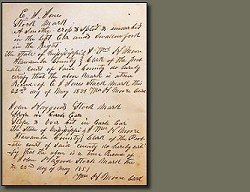 Old family letters are a gold mine for not only genealogical, but historical information as well. These priceless gems give a first hand account of such things as family events, deaths, marriages, and everyday life. There are many old family letters scattered about Itawamba County hidden in desk drawers and old trunks. One such old letter is from the William Beachum family.
Old family letters are a gold mine for not only genealogical, but historical information as well. These priceless gems give a first hand account of such things as family events, deaths, marriages, and everyday life. There are many old family letters scattered about Itawamba County hidden in desk drawers and old trunks. One such old letter is from the William Beachum family.After the Civil War, many Itawamba County families moved west to start a new life because the economy of the South was in ruin immediately after the war. During Reconstruction in 1872 a small group of Itawamba County families moved west to Monterey County, California, south of San Francisco. Included in this collection of families was my great great grandmother Mary Rhyne Gillentine’s (wife of William Throckmorton Gillentine and daughter of Jacob and Mary Hope Rhyne) brother’s family (Henry W. Rhyne). Other Itawamba families taking part in this trek to California were the Cook, Galloway and Beachum families of southwestern Itawamba County.
During August of 1872, William Beachum wrote a letter from their new home near Castroville, California giving an account of California and a description of their trip from Itawamba County where they boarded a Mobile & Ohio Railroad passenger train in Baldwyn and made the eleven day trek. This old family letter includes a most interesting account of their journey and includes a most interesting pen drawing of San Francisco in 1872 (click image for a larger view of the first page of the letter). Below is a transcription of the old letter:
Castroville Monterey Cty. Cal. Aug 7th, 1872
Dear son and daughter,
I now avail my self of the present opportunity of droping you a few lines in order to let you know that we are all in tolerable health at present and hope when these lines reach you may find you all good health. We rec’d yours yesterday date of 26th last month, which born the painful tidings of the death of that lovely babe George which was an idol amongst the whole family. Your ma scarcely slept any last night the shock so great. We also rec’d one from G. Martin by the same mail to the same effect. We know how to sympathise with you. We know the ties of nature binds strong the will of the Lord must be won therefore we should have those misfortunes with as much fortitude as possible.
When you answer this let us know how W.A. Evans is and Dr. Weare and whether he is gone to Colorado or not such has reached here. Say to those who may inquire after my welfare I will write at such time as I may think that I can interest them.
I am not prepared to boast of California as yet. I think the east ranges very healthy but my opinion so far as I can learn a hard country for a poor man to till when a good crop grows low and such high the general estimate for harvesting is $10 per acre no out lands to pasture if a cow, he must be tied in __ land and it __ for as much as what you cultivate upon the whole. If I don’t get well of my misery it may prove a bad move for us.
No chance to buy lands from $30 to $100 per acre than a quit claim and the government lands are in the mountains where there is neither timber land or water there for I shall not advise any one to come as yet. The boys are at work at $2 per day. Frank has not been home for near 5 weeks. Cook and wife are both complaining. She has a risen on her left hand which is painful.
We made the trip from Baldwin in 11 days at a cost of $92.66 each over and under mountains, across steep gulches under snow spread for miles in sight of snow for 3 days and sometimes it from 2 to 5 feet thick. From Omaha to Sacramento is what I would call a baren dessert with a few exceptions. Galloway and H.W. Ryne are all well. I design starting to San Francisco to morrow when I return I will calculate your ma and me will go to the hot springs 40 miles.
I will close for the present as my hand paining me. Read what you can of this and guess at the balance as it is as good as I can do. Give my regards to all enquiring friends and for Rhoda, yourself and the children, this balance, tell Mary and Becca we have not forgot them and be smart pretty little girls.
Your affectionate Father
Wm. Beachum
















